BY JANET STEINBERG
This is not a joke, though it could easily be mistaken for one on April Fools’ Day! On April 23, 1982, Key West, Florida, declared its independence from the United States, establishing itself as The Conch Republic. Their motto, displayed alongside the Conch Republic flag, states: “We Seceded Where Others Failed”.
THE CONCH REPUBLIC FLAG
And this is definitely not fake news. Here are the facts: The troubles began when the U.S. Border Patrol established a roadblock and inspection point on US 1, where the highway connects the Florida Keys to the mainland. Vehicles were stopped and searched for illegal immigrants and narcotics, leading to significant traffic delays and frustrations for tourists.
The locals, known as Conchs (pronounced “konks”), voiced their complaints, but they went largely ignored. In response, the City Council adopted the name Conch Republic and declared war on the United States. The war on April 23 lasted just one minute before the city’s Mayor (who was named Prime Minister) surrendered and requested one billion dollars in foreign aid. While they didn’t receive the funds, they gained a billion dollars’ worth of publicity.
Cayo Hueso, or “The Island of Bones,” as named by 18th-century Spaniards, is located 155 miles south of Miami. The Overseas Highway, sometimes called the “Highway that Goes to Sea,” is 113 miles long (including the famous Seven-Mile Bridge at Marathon) and connects all the Florida Keys to their southernmost point.
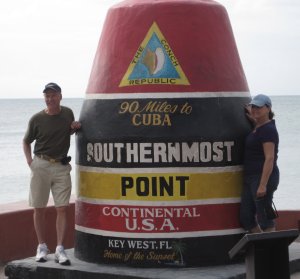
CONCRETE BUOY MARKS THE SOUTHERNMOST POINT OF THE CONTINENTAL U.S.A.
The Old Town Trolley and the Conch Tour Train navigate the palm-lined streets, which are home to the pastel-colored residences that once sheltered famous figures like Ernest Hemingway, Tennessee Williams, and John Audubon. “Papa” Hemingway arrived in Key West in 1928 while writing “A Farewell to Arms” and composed many of his renowned novels there, including “For Whom the Bell Tolls”, “To Have and Have Not”, and “The Macomber Affair”.
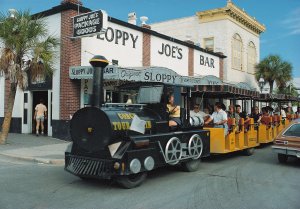
TWO KEY WEST FAVORITES: SLOPPY JOE’S AND THE CONCH TOUR TRAIN
A living tribute to the late author remains at his Spanish colonial mansion, which is home to approximately 40-50 polydactyl (six-toed) cats, descendants of the nearly 50 cats that lived there with Hemingway. An old urinal from Sloppy Joe’s—given to him by his close friend Joe Russell, who owned Hemingway’s favorite bar—has been transformed into the most famous cat drinking fountain in the world. The fountain features a discarded Spanish olive jar on top, while the trough is made from the urinal, surrounded by colorful tiles added by Hemingway’s then-wife, Pauline, to conceal its original purpose.
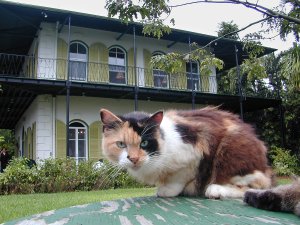
A PERMANENT RESIDENT OF THE HEMINGWAY HOUSE GIVES A DISMISSIVE GAZE TO A VISITOR
Another noteworthy feature is a penny embedded in the poolside patio. Having paid $20,000 for the first swimming pool built in Key West in the late 1930s, Hemingway took a penny from his pocket and pressed it into the wet cement around the pool. He then told his wife, “Well, you might as well take my last cent.” That wife, the second of four, ultimately divorced him, but the penny remains.
Harry Truman’s Little White House, which served as the President’s winter residence, is now an intriguing public museum. Stepping inside this modest two-story wooden home feels like visiting a friend for a meal or to hear fascinating fishing tales or play a round of poker. The furnishings are mostly original items used by the Trumans. On Truman’s mahogany desk sits a large green blotter, an ink pen, an inkwell, and the sign famously stating, “The BUCK STOPS HERE!”
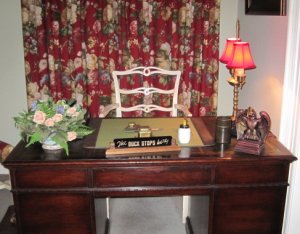
ICONIC SIGN ON PRESIDENT TRUMAN’S DESK AT THE LITTLE WHITE HOUSE
The Audubon House, where renowned artist and naturalist John James Audubon stayed in 1832, was the former residence of salvager and harbor pilot Captain John H. Geiger. It was restored over 130 years after Audubon painted some of his famous birds there. The Geiger tree, depicted in Audubon’s painting of the white-crowned pigeon, can be found in the house’s front yard. Another major attraction in Key West is the Mel Fisher Maritime Museum, where visitors can see treasures from the Spanish galleon Atocha.
Epitaphs found in Key West cemeteries are sure to bring a smile. One headstone reads, “At least I know where he’s sleeping tonight,” referring to a woman’s cheating husband. B.P. Roberts’s tombstone states, “I told you I was sick.”
The Southernmost Point in the continental United States, just 90 miles from Cuba, is marked by a large red concrete buoy at the intersection of South and Whitehead Streets. The small green “Mile 0” sign at the junction of Fleming and Whitehead Streets indicates the southern tip of U.S. Highway 1.
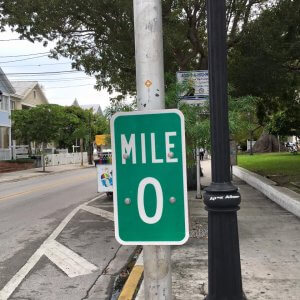
MILE 0 MARKS THE SOUTHERN TIP OF U.S. HIGHWAY 1
Your trip to Key West wouldn’t be complete without a visit to Captain Tony’s and Sloppy Joe’s. When Hemingway first arrived in Key West in 1934, he often visited a rough and tumble fisherman’s bar at 428 Greene Street, the original Sloppy Joe’s Bar, which became “Papa’s” favorite spot.
When the rent for Sloppy Joe’s increased, owner Joe Russell instructed patrons to pick up their drinks and stools, and they all moved to the bar’s current location at 201 Duval Street. The Greene Street bar then became known as Captain Tony’s.
These establishments can be described as colorful, honky-tonk, or tourist traps—regardless of how you label them, Captain Tony’s and Sloppy Joe’s embody the essence of Key West.
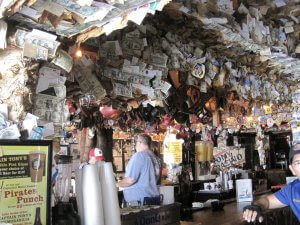
THE FUNKY BAR AT CAPTAIN TONY’S
In Key West, you can find a variety of cuisines, whether you prefer Conch-Caribbean, Cuban, Chinese, or Classical American fare. If you enjoy eating in a quirky, unpainted driftwood shack, B.O.’s Fish Wagon is the place to go for a fresh fish sandwich served on homemade Cuban bread. A hand-painted sign there cheekily states: “If it looks like fish and smells like fish, it ain’t fresh.”
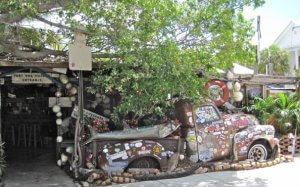
BO’S FISH WAGON
Yes, the sun sets every night, everywhere around the world. But in Key West, Florida, it’s not just another sunset—it’s a celebrated event! As the sun sinks into the horizon, creating a vivid orange glow, people gather in the southernmost city of the continental U.S. for a fiery celebration. Locals and visitors mingle with jugglers, belly dancers, and mimes at Mallory Square Pier to witness nature’s nightly spectacle.
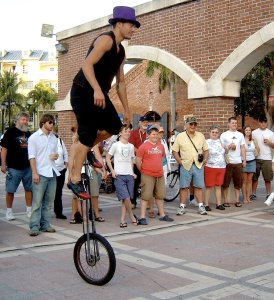
SUNSET AT MALLORY SQUARE PIER IS A NIGHTLY CELEBRATION
Key West is a fascinating island of contrasts—a place where pirates roamed and presidents relaxed. It’s a vibrant community where diverse lifestyles converge, blending Caribbean and continental influence, tradition and innovation. It’s a hub for the Conch people, conch fritters, conch chowder, the Conch Tour Train, Conch High School, and even the cheerleading squad known as the Conchettes. By the time you leave this final stop in the Florida Keys, you’re sure to feel “conch-ed out.”
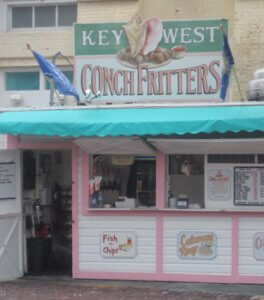
YOU’LL FEEL “CONCH-ED OUT” BY THE TIME YOU LEAVE KEY WEST!
JANET STEINBERG, winner of 55 national travel-writing awards, resides in Cincinnati but calls the world her home.
PHOTO CREDITS: Janet Steinberg



